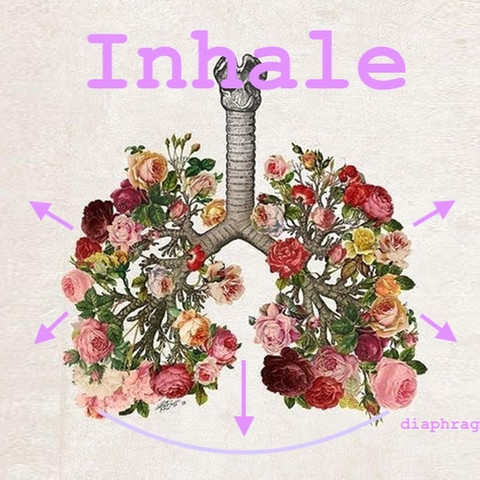Breathing Gives Us Life
- Sarah S. Giordano

- Mar 26, 2021
- 6 min read
Seasonal Insights by Sarah S. Giordano
Spring 2021

Spring has sprung and this year more than ever we prepare for a rebirth. As we anticipate the emergence from hibernation, we are brimming with the stored energy of 2020. This energy may be a mix of gratitude, love, faith, pain or loss but in some way we all evolved during the pandemic. The return of this newsletter is intended to cultivate this growth.
As an ER nurse working in NYC through the pandemic I noticed a need for basic education on caring for ourselves and was inspired to bring back this seasonal communication. Each season I will send you simple, tangible insights about health and happiness from my practice as a yogi and a nurse. This spring our focus will be on the fundamentals of breathing and building prana. Here is what you will find inside:
Respiratory system basics
How breath creates energy
Understanding prana
Deep breathing exercise
Building prana through song
Recipe: Kale Caesar

Springtime is a season of growth and new beginnings, plants slowly make their way out of slumber and reach into the earth with their roots. For us the breath is what awakens our roots. Breath gives us life. The act of breathing replenishes our bodies with energy, specifically prana.
Our experience in the era of COVID-19 draws us closer to the roll of the breath. Ventilator became a commonly used term. Leaving the house without a mask was like forgetting to wear pants, you get outside and think, ok something is really wrong here. Coughing in public has become more taboo than passing wind. We are now hyperaware of the importance as well as the vulnerability of the respiratory system.
How does the respiratory system work?

Filtration. When we take a breath we are inhaling the air around us, which is mostly hydrogen and oxygen, but also any dust, viruses, bacteria or other pollutants. Our respiratory system is designed to filter out what is not needed. Therefore it is preferable for the breath to travel through the nosefor two reasons:
1. The nose is lined with hairs and leads to a networks of cavities (the sinuses) which are both designed to filter the air before entering into the lungs
2. The nares (nostrils) are smaller than the mouth and therefore it takes longer to draw in air through the nose, automatically slowing down the breath, like drinking through a straw

Equalization of pressure. The pressure of the air surrounding us compared with the air inside our lungs is what stimulates our bodies to either inhale or exhale. Air trapped inside a balloon, if given the opportunity, would rush out sending the balloon flying around the room. Same holds true for the lungs. We inhale because the air around us is at a higher pressure and needs somewhere to go. We exhale because the pressure has now built up inside the lungs and needs to be let out.
Oxygenation. Once air enters into the body, it travels down a pipe called the trachea and moves into smaller and smaller pipes called bronchi until it reaches thousands of tiny sacs called alveoli. It is here in the alveoli where the circulatory system shows up to collect oxygen from the inhaled air and begins distributing it throughout our bodies, giving us life.
Detoxification. The circulatory system drops off any unwanted byproducts, namely carbon dioxide, at the alveoli to be released on the exhalation. This release of byproducts is detoxifying our bodies. Each breath is a cycle of replenishing the body with life and releasing unwanted waste. All of this happens with or without our awareness. Miraculous!
How does breathing effect our emotional state?
We have a blanket of muscle tissue covering the base of the lung cavity, called the diaphragm. This muscle expands downward towards the abdomen as we inhale allowing the full capacity of the lungs to be inflated and then curls up into the lung space as we exhale squeezing out air from all the little sacs.
The intentional use of the diaphragm during breathing exercises is called diaphragmatic breathing (see below). Deep breathing slows down our breathing, our heart rate, and even our emotional and mental state of being. This is because receptors found in the diaphragm are linked to areas of the brain which process our emotions.
In yoga the breath is fundamental for this reason. When beginning a yoga practice you may start by becoming aware of your physical body and focus on wrapping it into the different positions. As a teacher I am completely tuned into your breath. How fast are you breathing? How deep are you breathing? Are you breathing through the nose? No matter what position the body holds if there is no breath there is no energy and there is no life.

As our yoga practice progresses we become more comfortable in our physical bodies, more postural, and more flexible. Then it is the breath which carries the practice into an energetic state of consciousness building life force (prana) and storing it in the body to be used throughout the day to manifest our purpose in life.
What is prana?
Prana is the vital life force that animates all living beings. Prana enables the body to move and the mind to think.
Breathing is a primary and immediate source of obtaining prana. We can also gather prana from food, sleep and positive thoughts or emotions, such as gratitude. Prana can be lost just as easily from a diet lacking in pranic energy, poor quality sleep and negative thoughts or emotions.

The key is to find balance and channel prana allowing us to enjoy our unique talents and live life with meaning and purpose. For a deeper dive into how prana manifests check out this video.
When we fill ourselves with prana and channel that prana for vitality we surpass the vulnerabilities of the physical body and can even slow down the aging process. This Spring, as we begin our journey together in preparation for emergence from this loooong hibernation, explore your breath with consciousness. Draw in the life force. Re-vitalize the Self throughout each day. This is our foundation.
How to Practice Deep Breathing
This video walks through the basics of diaphragmatic breathing. All levels welcome. I recommend practicing a few times a week until the feeling of breathing deep into the body becomes more natural.
Wisdom of the Breath
Spring is a time of rebirth and growth. Building a foundation of breath work is fundamental to this growth. Here is a mantra, or chanting practice, created to honor the wisdom of the breath and in so doing strengthen our respiratory system and of course cultivate prana.

Pavan, Pavan, Pavan, Pavan,
Par Para, Pavan Guru
Pavan Guru, Wahe Guru,
Wahe Guru, Pavan Guru
Translation:
"The air, the air, the air, the air. The Infinity and beyond the Infinity. The air is the Teacher. The air is the Teacher. Wha! The Teacher is beyond description. Wha! The Teacher is wonderful. The air is the Teacher."
Try singing along with the link below for 7-11 minutes daily and explore how it effects your mood, thoughts and physical body.
Kale Caesar Salad
inspired by Dr. Joel Fuhrman
In springtime when everything is turning green and the weather is warming up, I start looking for lighter meals compared to the heavy cravings of the winter time. As discussed, prana comes from the breath, food, sleep and positive thoughts. Fresh raw vegetables by far hold the most pranic energy as they are full of life. In addition to eating green leafy veggies, sprouts, and micro greens this season, make sure you stay hydrated as the best medicine for healthy lungs is hydration.

Ingredients
1 bunch of kale
4 slices bread (I used pumpernickel)
1/2 cup raw cashews
6 ounces firm silken tofu
3 large cloves garlic
2 medium celery stalks
1/2 cup water
1/4 cup fresh lemon juice
1/2 tsp white miso
2 tsp dijon mustard
2 pitted dates (soaked for 10 minutes)
1 tsp kelp granules
2 tbsp nutritional yeast
fresh ground black pepper to taste
Preheat the oven to 350F.
Wash the kale and remove the spiny bit from each leaf. Finely chop the leaves.
Roughly chop the bread and place it on a baking sheet. Bake for 15 minutes turning over half way through.
Combine all remaining ingredients in a higher speed food processor and blend.
Toss together kale, bread and dressing mixing well. You may have extra dressing which can be stored in the fridge. Option to top with hemp seeds or chopped walnuts.
Enjoy!

I hope you have enjoyed this food for thought and utilize the actionable practices I have shared to promote health and vitality.
To receive regular seasonal updates directly in your inbox sign up for our newsletter below
If you are looking to dive deeper and explore how this subject relates to you specifically contact me to request a free consultation. I am available for private yoga classes online or in-person if you live in NYC.
Sarah S. Giordano
Take this moment and thank yourself for dedicating time to the mind, body and spirit.
Enjoy this season of emergence.
Namaste






Comments